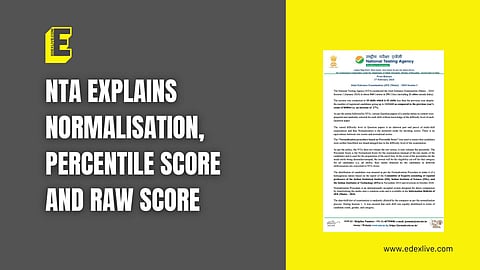

"It is reiterated that the JEE (Main) – 2024 Session 1 examination has been conducted as per the norms and procedures followed for the conduct of any high-stakes examination thereby providing fair and equal opportunity for all candidates", the press release put out by the National Testing Agency (NTA) today, February 17, read.
Experts had raised concerns regarding the disparity between marks and percentiles in this year's JEE and it is addressing these concerns that the NTA put out the press release.
It went on to explain what exactly is normalisation procedure. This is what it said:
What is the biggest advantage of normalisation?
Normalization Procedure is an internationally accepted system designed for direct comparison by transforming the marks onto a common scale.
The “Normalization procedure based on Percentile Score” was used to ensure that candidates were neither benefitted nor disadvantaged due to the difficulty level of the examination
Why is normalisation the preferred mode for deciding scores?
As per the norms followed by NTA, various Question papers of a similar nature in content were prepared and randomly selected for each shift without knowledge of the difficulty level of each Question paper.
The varied difficulty level in Question papers is an inherent part and parcel of multi-shift examination and thus Normalization is the preferred mode for deciding scores. There is no equivalence between raw scores and normalized scores.
Why are raw scores not released?
As per the policy, the NTA does not release the raw scores, it only releases the percentile. The Percentile Score is the Normalized Score for the examination (instead of the raw marks of the candidate) and is used for the preparation of the merit lists.
In the event of the percentiles for the multi-shifts being dissimilar/unequal, the lowest will be the eligibility cut-off for that category for all candidates (i.e. all shifts). Raw marks obtained by the candidates in different shifts/sessions are converted to NTA Score.
How is the distribution process done?
The distribution of candidates was ensured as per the Normalization Procedure to make it of a homogenous nature based on the report of the Committee of Experts consisting of reputed professors of the Indian Statistical Institute (ISI), Indian Institute of Science (IISc), and the Indian Institutes of Technology (IITs) in November 2018 and reviewed in October 2020.
What does the percentile score indicate?
The Percentile Score indicates the percentage of candidates that have scored EQUAL TO OR BELOW (same or lower raw scores) that particular Percentile in that examination. Therefore the topper (highest score) of each shift will get the same Percentile of 100 which is desirable. The marks obtained between the highest and lowest scores are also converted to appropriate Percentiles as per the following formula:
The percentile of candidates appearing in various shifts of the JEE (Main) – 2024 Session 1 calculated as per the above formula and declared on 12 February 2024, is as under:
